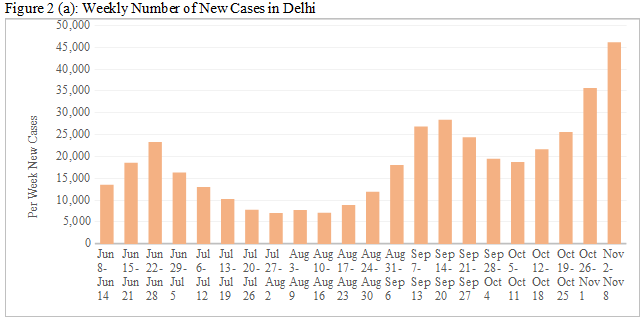Delhi’s Covid-19 Threat: Why the National Super Model’s Predictions Diverge from Reality

Representational image. | Image Courtesy: Telangana today
In sharp contrast to the predictions of the Indian Supermodel for Covid-19 Pandemic (or National Super Model) developed by the Department of Science and Technology (DST), coronavirus cases in Delhi have been on a rise. In fact, the figures for active cases in Delhi had started diverging from that of the model’s predicted figures almost a week before the report of the DST was officially released; from October 13 the actual active cases in Delhi started moving upwards.

A number of models have been developed over the period since the Covid-19 pandemic struck the globe. Researchers have tried to improve their predictions by making modifications and using different techniques of analysis. However, none has been able to predict the trajectory of the pandemic correctly for the simple fact that the human element in question – human interactions, human responses, human behaviour - is difficult to predict.
In a presentation to the media, the authors of the National Super Model paper did add the caveat that “Upcoming festival and winter seasons may increase the susceptibility to infection.” However, the sharp divergence between actual active cases and modelled predictions even before the city entered the festive season indicates that the models can go wrong and a public health policy cannot be designed on the basis of these models. With the model predictions not holding ground within the first week of its official release, it becomes a little difficult to pay heed to the proclamation of the authors that “if all of us follow these protocols, the pandemic can be controlled by early next year with minimal active symptomatic infections by February-end.”
In an interview, Prof. Satyajit Rath, Scientist (IISER, Pune), differs with the conclusion of the National Super Model that by following the safety protocols, the pandemic can be controlled by February 2021. He argues that the virus spreads by human contact and this kind of spread cannot be modelled accurately, just as we falter in predicting the monsoons accurately even now.
Many researchers have stressed on the difference between “academically relevant research and policy-relevant analysis” and the need for exercising caution while using such statistical techniques in guiding public health policies. It is all the more dangerous when such technical analysis is apparently done in haste, with a possibility of using it for furthering specific political agenda. The National Super Model has been questioned by some experts on the grounds of being “shoddy” in analysis and doubtful credentials as a “scientific” paper due to a number of questionable aspects of the research undertaken.
Prabir Purkayastha questions the estimates arrived at by the model in, one, “grossly overestimating the number of infected’ and, two, the claim of reaching herd immunity with 30% of infected population while the consensus among epidemiologists is at a figure of 60-70%. The World Health Organisation (WHO) also states that “it needs at least 60 to 70% of the population to have immunity to really break the chain of transmission”. In fact, according to Caitlin Rivers, an epidemiologist at the Johns Hopkins Center for Health Security in the United States, “herd immunity is something that can be observed with certainty only by analysing the data in retrospect, maybe as long as ten years afterwards.”
The Super Model has been criticised on other grounds as well. Gautam Menon, Professor at Ashoka University, has questioned the assumptions of the model as well as the inclusion of a large number of parameters used for different time periods. The authors of the model themselves rue that the “utility of our projections is limited by the accuracy and reliability of the available data”. Prof. T. Jacob John, former head of the department of virology at Christian Medical College, Vellore, has said that “the national epidemic is a ‘figment of statistical imagination,’ and instead, there are 100 or more small epidemics in different states and cities, rising and falling at different times.” Thus, a number of experts point out the futility of the Super Model in correctly predicting the trajectory of the pandemic, its credibility, as also the dangers of using it for the purposes of formulating public health policies to combat the pandemic.
Recent Covid-19 related Trends in Delhi
After hitting a low of 7,071 new cases per week in the week of July 27-August 02, the Covid-19 cases in Delhi have been rising gradually, so much so that 7,745 new cases were reported in a day on November 08. For the week of November 02-08, the total new cases recorded in Delhi were 46,159, as shown in Figure 2 (a).

Source: Compiled from www.covid19india.org
There has been a rise in both the number of weekly new tests along with weekly new cases. There was a jump in number of tests being conducted in the first week of September and tests have remained more than 3,50,000 per week since then, as shown in Figure 2 (b).

The reason given by the Delhi Government for a sudden rise in the number of Covid-19 cases is a change in testing strategy whereby aggressive tracing and testing are being conducted and the RT-PCR tests have been increased. Delhi is witnessing a rise in both the number of tests being conducted and the number of confirmed cases emerging.
Along with this, a rise in positivity rate – ratio of confirmed cases to number of tests – indicates that the rate of increase in number of cases is much higher than the rate of increase in number of tests. The positivity rate increased from as low as five percent in the beginning of October to 12% in the first week of November.
However, such a sharp rise in number of cases in Delhi cannot be solely ascribed to the increase in number of tests.
The Impact of Un-lockdown
The recent spike in cases may be linked to the gradual relaxation of restrictions, many of which were effected from October—such as opening up of weekly markets, bars and restaurants, and cinema halls/theatres/multiplexes. The Delhi metro had already started operating since mid-September. The Union government, announcing Unlock 5 guidelines on September 30 and then extending these till November 30, had instructed state governments to not to impose local lockdowns outside containment zones without consulting the Ministry of Home Affairs. Although, initially, the Delhi government deferred the implementation of Unlock 5 guidelines, it eventually went along with the Centre.
It is such factors that the statistical modelling techniques do not capture adequately and may give erroneous results. Any public health policy needs to be mindful of this and thus, should not be formulated on the sole basis of results of a model. Models are akin to the results obtained in a laboratory set up and hence, they need to be grounded in real life evidence, experiences and developments. In Delhi the real figures have already diverged from those predicted, as also being observed in a few more states. What can rather be done with a fair amount of confidence and with tangible results is to strengthen the public health system to deal with any eventuality and that would mean ensuring universal access to affordable healthcare services, adequate and quality health infrastructure, human resources, medicines, and other facilities.
(Data collated by Peeyush Sharma and Pulkit Sharma of NewsClick Data Analytics team.)
Get the latest reports & analysis with people's perspective on Protests, movements & deep analytical videos, discussions of the current affairs in your Telegram app. Subscribe to NewsClick's Telegram channel & get Real-Time updates on stories, as they get published on our website.
























